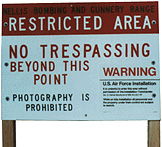
Area 51
Part Two
Rich also forecasts remote control and robotics as the future of warfare, as the public and politicians get more squeamish about American casualties. Rich also sees a future in technologies to disable enemy armies without killing them: a piercing wall of sound that would stop advancing armies, lasers that would cause temporary blindness, etc.
...Hear No Evil
But even if the Air Force is using Groom Lake to develop the Aurora or some high-tech stereo system that curdles the milk in the teats of cattle, is all the secrecy necessary? After all, photos of Area 51 are widely available--even Russian satellite photos. And under the "open skies" treaty, ratified by Congress and signed by George Bush, even former Warsaw Pact nations now fly over the facility and snap away. "So it's a secret only to the American public," Aftergood notes.
But all this just makes the Air Force more determined. On the road to Freedom Ridge, for example, hikers eventually meet a row of fence poles and a sign that reads: "Warning. Restricted Area. Use of Deadly Force Authorized. Photography is Prohibited."
And the lid is only getting tighter. The Air Force wants to seize roughly 4,000 acres of public land, including Freedom Ridge, where views of the base are clearest. Though there are dozens of military ranges--even bombing ranges--that lack even the most basic warning signs, the Air Force says it needs the additional land around Groom Lake as a safety buffer. No bombs are dropped within 50 miles of the ridge, but the Air Force says it needs to "insure public safety."
This statement from an Interior Department document, however, is perhaps more on target: "Public viewing of military activities (which has often included illegal photography of range activities) has increased during the past few years, necessitating the diversion, postponement or cancellation of missions."
Others sense a more sinister scheme. "I think the Air Force wants more land so it can continue the burning of toxic wastes without people looking in from Freedom Ridge," says Danielle Brian, who directs the Project on Government Oversight in Washington.
Freedom Ridge fans are skeptical of the military's motives for good reason. In 1984, the Air Force seized its first buffer zone around the base in order to pull Bald Mountain, then a prime (though rarely used) viewing location, from the public domain. The Air Force took no legal steps to obtain control of the land it wanted. It simply set up a guard shack adorned with a sign: "Warning. US Government Property. No Trespassing Allowed. Violators will be prosecuted to the fullest extent of the law."
Even those who ran cattle and were working mining claims on the land were turned away by heavily armed guards. "Many people equate this to an armed invasion by our own military," says Glenn Campbell.
At first, the Air Force denied it had anything to do with the guards. Only later, after it officially applied for the land, did an Air Force spokesperson admit his employer had illegally seized the land. "We had no legal authority, but we asserted the right to request that people not enter," the spokesman told Congress.
But even that hearing would not have occurred if legislators hadn't noticed that the Air Force had quietly slipped an additional 4,680 acres into its routine request for reauthorization for the Nellis Air Force Gunnery Range. Despite the foul play, Congress ultimately approved the 1984 land-grab, and Bald Mountain is now well within the restricted area.
But what concerns Campbell is that the Air Force is not doing the job right. "They forgot Tikaboo Peak, where you'll still be able to see the base, although from further away," he says.
Many speculate that the Air Force isn't taking the more distant peak because if it did, the total expansion would exceed 5,000 acres. Under federal law, all expansions over 5,000 acres require congressional approval. "And there's nothing more terrifying to the military than having to deal directly with Congress," Campbell notes.
In the meantime, Freedom Ridge is becoming ever more popular with tourists who come from as far away as Australia to get a last glimpse. The Swiss Mountain Bat, a self-described UFO and aeronut, traveled from Switzerland. "I felt like I was standing next to the Berlin Wall in the '60s," he said. "You're standing there on this beautiful mountain and all of a sudden there's this white jeep and two guys watching you with huge binoculars. It's creepy."

Part One

Home